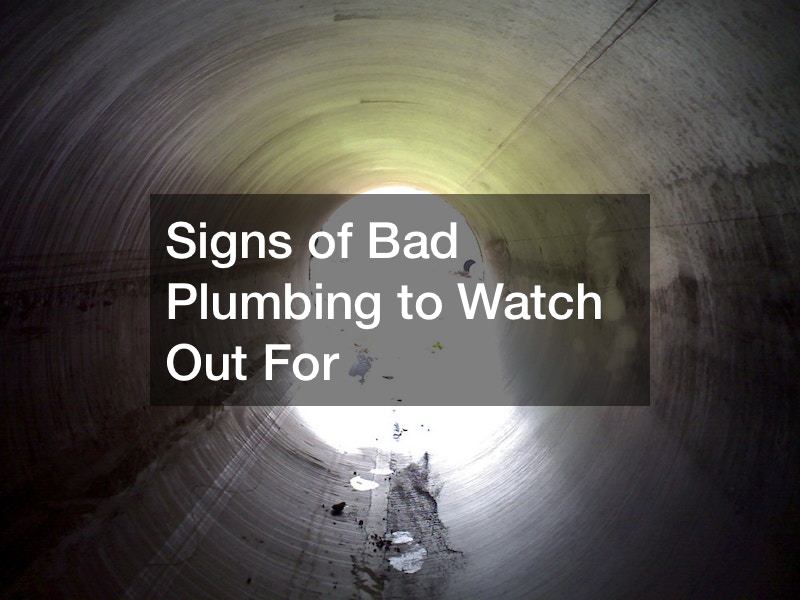

Have you ever questioned why plumbing issues almost always occur without warning? In many cases, you might have chosen to ignore the signs for various reasons.
A plumbing problem can materialize very rapidly. For instance, a leaky pipe can cause water damage to your house, possible mold growth, and increased utility costs. According to Forbes, you should expect to pay an average of $400 whenever you call a plumber for repair work. However, the substantial repairs cost anywhere from a few hundred to several thousand dollars.
This article looks at 17 warning signs that you have a significant plumbing problem that requires immediate fixing. Read on to learn how to prevent minor issues from becoming big ones.
17 Signs of Bad Plumbing to Watch Out For
You’ll discover a list of frequently disregarded indications of plumbing problems in your home below. Remember that even though one of these indications might not seem serious enough to warrant calling a plumber, several signs or recurrent occurrences indicate that immediate action is required. Let’s jump right in.
1. Low Water Pressure

Good water pressure is a luxury many take for granted until it suddenly disappears. Remember, the average person in the United States uses approximately 90 gallons of water daily, according to 2oceansvibe. A strong and consistent water flow determines water pressure via your pipes, and in turn, from your shower head and sink faucets. There is an immediate reduction in water pressure when certain fixtures become defective.
The solution to overcoming a low water pressure problem is not to overlook it. The problem isn’t just that there isn’t enough pressure in your shower; it’s a sign of much bigger issues within your plumbing system. Check other water outlets in your home if you notice a decrease in water pressure in one location.
Remember that low water pressure may not be limited to your home. There could be dozens more residences affected if a water main breaks in the area. So, the sooner you engage plumbing services to isolate and resolve the issue, the better.
2. Faucet Leaks
Leaky faucets are other obvious signs of bad plumbing that indicate you should call a plumber immediately. The problem usually comes in the form of a slow drip. When the house is silent and quiet, you might hear a trickle. It may be evident enough to detect while standing at the sink or walking by.
Leaky faucet repairs are usually straightforward, but you’ll need specific essential tools and basic home leak repair skills. Remember that the longer a leaky faucet remains unfixed, the more water you’ll waste, costing you money on your water bill and squandering water you could use elsewhere. According to Comfy Living, small leaks can waste up to 10,000 gallons of water annually.
3. Wobbly Toilet
Another telltale sign that something isn’t right is if your toilet wobbles when you sit on it. Hopefully, all you need to do is tighten the seat. If the bowl is wobbly, look at the bolts that support the toilet to the floor. If the bolts are snug, but the bowl still wobbles, the wax seal surrounding your toilet drain may have broken, allowing water to eat away at your subfloor. According to the EPA, a leaking toilet can waste up to 200 gallons of water every day.
4. The Grass is Greener

It may seem strange, but the grass becomes greener when sewage leaks. This is because sewage contains many nutrients and functions as a fertilizer. This issue also affects people with septic pumping; the grass becomes greener as the surrounding fields become oversaturated.
This stealthy damage to the external component of your plumbing system, whether caused by decaying materials or invasive tree roots, must be addressed. If you have green grass but just in some areas, or if you notice water pooling in your yard, it’s time to hire a plumbing service.
5. Bad Odor
Most of what we’ve spoken about so far can be detected with your eyes, but your sense of smell may be necessary for detecting plumbing issues like a leaky propane tank or sewage odors.
An unpleasant smell is frequently linked to home plumbing. Toilet bowls usually stink, the bottom of the sink stinks like sewer, and the plumbing pipes smell like rust. We must dispel this misconception and acknowledge that sewer odors, mainly, are uncommon in house plumbing and should be treated as such.
If you smell rust or sewage gas in your plumbing fittings, it could be a symptom of a developing plumbing issue. You’ll sense when your sewage line is clogged and backing up, and it is among the many signs of bad plumbing that require a plumber to conduct an inspection.
6. There is Little or No Hot Water

If your faucets only produce cold water, you may have a problem with your water heater or boiler. Cold water from a water heater can be caused by various issues, including malfunctioning valves and corroded thermostats. Hire a plumbing professional for heating and cooling services to save time and money on repairs or replacements.
7. Slow Drainage
It should be no surprise that a slow drain indicates signs of bad plumbing. There are two possibilities for this problem: hair clogs or food clogs. However, when many drains are slow, it can indicate a more significant plumbing issue.
Slow drains are one of the earliest symptoms of a problem somewhere in your system, and if left unchecked, they can escalate to worse problems. This could result in leaks and water damage, unclean and stagnant water, water stains, and sewage overflow. Depending on where the problem is, it could be a simple blockage at the drain or a problem further down the line that will necessitate extensive snaking.
Fortunately, a little detective effort should help narrow down the issue. Cleaning out a small clog is an excellent do-it-yourself treatment, but slow drains throughout the house are typically an indication of a more significant problem, such as tree roots in the sewage system.
8. Recurring Sink Clogging
Blockage is something every household experiences, which you should consider normal. According to PR Newswire, over 20% of homeowners have a clogged toilet regularly, whereas just 9% have a clogged sink. When you or someone else drops a large chunk of food under the drain cover, it can cause water to drain slowly into the sink, which is usually simple to fix. You can even use natural methods to unclog your sink. Keep these frequent reasons for sink clogs in mind so you can avoid this plumbing problem.
However, if you have a clogged sink every week or more, there may be a deeper plumbing problem that is not visible to the naked eye. In such instances, hiring a plumbing service for an inspection is preferable.
9. Pipes with Discoloration
Take a close look at your pipes the next time you’re in the basement or beneath the kitchen sink to check if there are any indications of discoloration, particularly around a joint. If this is the case, it strongly indicates signs of bad plumbing. This could be due to a sink or drain line leakage or something more serious, like a slow leak in the supply line. If the latter is the case, you should indeed prioritize this task. A slow leak has the potential to escalate quickly into an enormous catastrophe!
10. Increasing Water Bills
A sudden water bill increase is more than a financial annoyance. It’s also a clue that something in your plumbing system has changed. If you haven’t made any changes to warrant an increase in water usage (for example, filling up a pool or irrigating your lawn more frequently than usual), you should start troubleshooting to see if your pipes are leaking. A leaking toilet is the most typical cause of an increase in your water bill. Many homeowners are unaware of how much water a toilet consumes; the toilet valve is a garden hose on full blast, and a single-running toilet may waste hundreds of dollars in water leaks.
11. Noisy Pipes
Pipes in your home should always be visible rather than audible. This may seem apparent, but you’d be amazed how many people become used to noisy pipes and disregard them. However, rattling pipes are signs of bad plumbing, especially if the pipes generate noise while no one is using the water. When this occurs, you should immediately contact a specialist.
12. Deterioration in Water Quality
Be wary of the odor and color of the water from your tap because a clogged plumbing pipe might lead to pollution. The most prevalent source of water pollution is a leak or damage to the plumbing components that prevents sewage gas or water from entering your plumbing pipe. Rust on the inside of the pipes could be to blame.
Brown or muddy water can indicate that your water contains iron or that your water heater is malfunctioning. Blue or green water might indicate corroding copper pipes, which you should replace as soon as possible. However, there are some other indicators that your water heater needs to be replaced:
-
- If the hot water faucet does not provide any hot water, it is possible that the pilot light has burned out or that your water heater has reached the end of its useful life.
- The water is severely discolored and rusty rather than clear; this could indicate that the iron plumbing of the piping has rusted over time.
- The water is heavily sedimented.
- The water takes far too long to heat up.
- Water is accumulating at the tank’s bottom.
13. Mildew and Mould
When mold and mildew grow on your walls, you have signs of bad plumbing! You should address it immediately because it can harm your health. According to PMI, 1.4 million children die yearly from diarrhea caused by contaminated water and poor sanitation, with one child dying every 20 seconds. The presence of mold could indicate that your home is simply too humid. Examine the airflow in your home and consider purchasing a dehumidifier. The mold that appears mostly on one surface, on the other hand, is almost certainly the result of a leak.
14. Spots of Dampness
Damp spots are more evident signs of bad plumbing. If your carpet is wet in one location for no apparent reason, your ceiling is beginning to sag, or your walls are unusually damp, you almost certainly have a leak somewhere. Call licensed plumbers instead of poking around in there yourself.
15. Bubbling Ceiling or Walls
When the paint on a wall or ceiling starts to bubble or peel off, it’s usually a sign of moisture. A leak in the roof or plumbing system is the most prevalent cause of this problem. According to the Environmental Protection Agency, Americans waste approximately 1 trillion gallons of water annually. Don’t be among the statistics. So if you notice paint blistering, or brown patches emerging on a ceiling or wall, it’s time to start looking into what’s wrong.
16. Water Meter is Running for No Apparent Reason
When no water flows in your home, your water meter’s needle or digital readout will not move or change numbers. If you leave your taps off at home alone and your water meter still reads, it isn’t a good sign.
This indicates a water leak somewhere in your system. Can’t find the source of the leak? Hire the services of a plumber to find and repair the leak.
17. No Water
Last but not least, if you turn on the faucet and no water comes out, you have a significant plumbing problem. Of course, check your other fixtures to ensure the problem isn’t limited to a single location. When there is no water flowing, you should contact a water leak-detecting company as soon as possible since you may have a serious leak. Water is life, and you can’t leave without some, can you?
If you notice these signs of bad plumbing, you should immediately contact a professional plumber to avoid a catastrophic problem. Unless you are a plumbing professional, you will likely require their assistance to address the problem and save your property from water damage and other connected issues.
According to IBIS World, there are around 120,467 plumbing companies in the United States. Nonetheless, with so many options on the market, selecting the appropriate plumber for your plumbing requirements can be difficult. In that situation, you should consider a few things to help you make the best hiring option. For example, checking your prospect’s years of experience and track record will help determine whether they’re authentic and trustworthy. Knowing their pricing structure might also help you assess whether they fit your budget well.
How to Avoid Plumbing Problems

Preventing disease is better than curing it, as the saying goes. When it comes to plumbing, preventative steps are the greatest approach to safeguard your home’s plumbing system – and your wallet. In fact, according to the EPA, having a skilled plumber locate leaks can save up to 10 gallons of water every day. Plumbing services help you cover your bases, from annual inspections to large and small repairs.
Final Note
Have you noticed any of these signs of bad plumbing? Don’t panic! These problems are easily avoidable. You simply need to establish a proactive mindset and call competent licensed plumbers to check and investigate why such things occur in the first place. Addressing plumbing issues early on can prevent serious damage, major repairs, and illnesses. You will save a massive amount of money that you could invest elsewhere. Don’t wait, act now!





